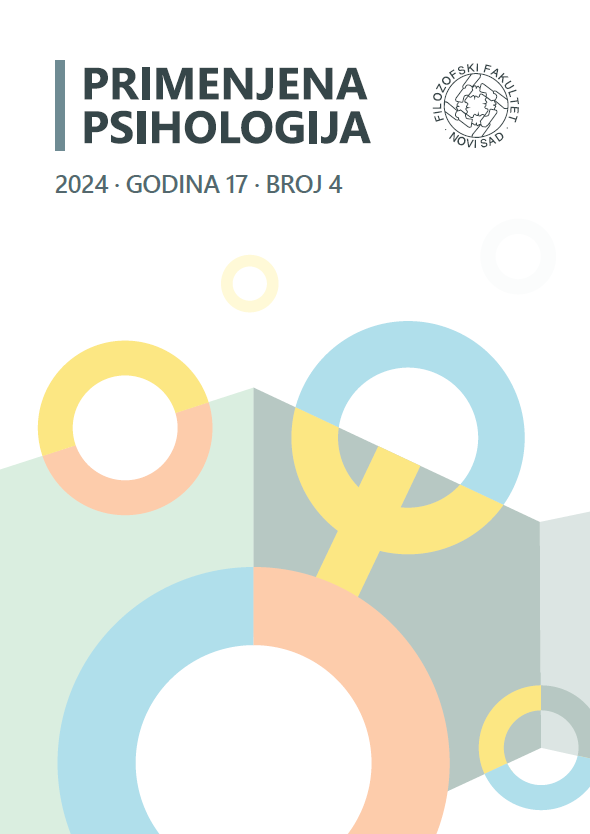Interpersonal cognitive distortions as a mediator for the effects of social anxiety and depression on loneliness among college students
DOI:
https://doi.org/10.19090/pp.v17i4.2527Keywords:
loneliness, social anxiety, depressive symptoms, cognitive distortions, studentsAbstract
The aim of the research was to verify whether interpersonal cognitive distortions underlie the relationship of social anxiety and depression symptoms with loneliness among student population. The data of 228 students from various studies in the Republic of Croatia were collected, mostly students who attend programs in social sciences (72.8%) and undergraduate students (74.1%). The research was conducted online. Participants completed The Depression, Anxiety and Stress Scale, The Loneliness Scale, The Interpersonal Cognitive Distortion Scale, and The Interaction Anxiety Scale. Through two mediation regression analyses, loneliness is separately predicted based on social anxiety and depressive symptoms, with the verification of the mediation effect of interpersonal cognitive distortions. In addition, two more mediation regression analyzes were conducted to control the effects of depressive symptoms in the model in which the predictor was social anxiety and to control the effects of social anxiety in the model in which the predictor was depressive symptoms. Social anxiety in addition to interpersonal cognitive distortions explains 26.8% of the variance of loneliness, and depressive symptoms in addition to interpersonal cognitive distortions explains 29.7% of the variance of loneliness. Partial mediation was established in both analyses, i.e. social anxiety and depressive symptoms predict loneliness directly, and indirectly through interpersonal cognitive distortions. The results are discussed in the context of the existing literature, along with suggestions for practical implications in counseling work.
References
Allen, N. B., & Badcock, P. B. (2003). The social risk hypothesis of depressed mood: evolutionary, psychosocial, and neurobiological perspectives. Psychological Bulletin, 129 (6), 887. https://doi.org/10.1037/0033-2909.129.6.887 DOI: https://doi.org/10.1037/0033-2909.129.6.887
American Psychiatric Association. (2022). Diagnostic and statistical manual of mental disorders (5th ed., text rev.). https://doi.org/10.1176/appi.books.9780890425787 DOI: https://doi.org/10.1176/appi.books.9780890425787
Auerbach, R.P., Mortier, P., Bruffaerts, R., Alonso, J., Benjet, C., Cuijpers, P., Demyttenaere, K., Ebert, D.D., Green, J.G., Hasking, P., Murray, E., Nock, M.K., Pinder-Amaker, S., Sampson, N. A., Stein, D.J., Vilagut, G., Zaslavsky, A.M. & Kessler, R.C. (2018). WHO WMH-ICS Collaborators. WHO World Mental Health Surveys International College Student Project: Prevalence and distribution of mental disorders. The Journal of Abnormal Psychology, 127(7), 623-638. https://doi.org/10.1037/abn0000362 DOI: https://doi.org/10.1037/abn0000362
Batmaz, S., Kocbiyik, S. & Yuncu, O. A. (2015). Turkish version of the cognitive distortions questionnaire: psychometric properties. Depression Research & Treatment, 2015, 1-8. https://doi.org/10.1155/2015/694853 DOI: https://doi.org/10.1155/2015/694853
Beck, A. T. (1976). Cognitive Therapy and the Emotional Disorders. International Universities Press, Oxford.
Bertha, E. A. & Balázs, J. (2013). Subthreshold depression in adolescence: A systematic review. European Child & Adolescent Psychiatry, 22, 589–603. https://doi.org/10.1007/s00787-013-0411-0 DOI: https://doi.org/10.1007/s00787-013-0411-0
Burns, D. D. (1999). The Feeling Good Handbook, Revised Edition. Penguin Books.
Burušić, J. (2009). Samopredstavljanje: Taktike i stilovi. Naklada Slap.
Chrismore, S., Betzelberger, E., Bier, L. & Camacho, T. (2011). Twelve-step recovery in inpatient treatment for Internet addiction. In K. S. Young i C. N. de Abreu (Eds.), Internet addiction: A handbook and guide to evaluation and treatment (pp. 205–222). DOI: https://doi.org/10.1002/9781118013991.ch12
Clark, D. M., & Wells, A. (1995). A cognitive model of social phobia. In R. G. Heimberg, M. R. Liebowitz, D. A. Hope, & F. R. Schneier (Eds.), Social phobia: Diagnosis, assessment, and treatment (pp. 69–93). The Guilford Press.
Danneel, S., Nelemans, S., Spithoven, A., Bastin, M., Bijttebier, P., Colpin, H., Van Den Noortgate, W., Van Leeuwen, K., Verschueren, K. & Goossens, L. (2019). Internalizing Problems in Adolescence: Linking Loneliness, Social Anxiety Symptoms, and Depressive Symptoms Over Time. Journal of Abnormal Child Psychology, 47(10), 1691-1705. https://doi.org/10.1007/s10802-019-00539-0 DOI: https://doi.org/10.1007/s10802-019-00539-0
De Jong Gierveld, J. & Van Tilburg, T. G. (2006). A 6-Item Scale for Overall, Emotional, and Social Loneliness: Confirmatory Tests on Survey Data. Research on Aging, 28(5), 582–598. https://doi.org/10.1177/0164027506289723 DOI: https://doi.org/10.1177/0164027506289723
De Jong-Gierveld, J. & Van Tilburg, T. G. (1999). Manual of the Loneliness Scale. Methoden en technieken. https://doi.org/10.17605/osf.io/u6gck
Demir, Y. & Kutlu, M. (2016). The Relationship between Loneliness and Depression: Mediation Role of Internet Addiction. Educational Process: International Journal, 5(2), 97- 105. http://dx.doi.org/10.12973/edupij.2016.52.1 DOI: https://doi.org/10.12973/edupij.2016.52.1
Fung, K., Paterson, D. & Alden, L. E. (2017). Are social anxiety and loneliness best conceptualized as a unitary trait? Journal of Social and Clinical Psychology, 36(4), 335–345. https://doi.org/10.1521/jscp.2017.36.4.335 DOI: https://doi.org/10.1521/jscp.2017.36.4.335
Hamamci, Z. & Büyüköztürk, Ş. (2004). The interpersonal cognitive distortions scale: development and psychometric characteristics. Psychological Reports, 95(1), 291-303. https://doi.org/10.2466/pr0.95.1.291-303 DOI: https://doi.org/10.2466/pr0.95.1.291-303
Hamamci, Z. & Duy, B. (2007). The Relationship Among Social Skills, Dysfunctional Attitudes, Irrational Beliefs, Interpersonal Cognitive Distortions and Loneliness. Eurasian Journal of Educational Research, 7 (26), 121-130. https://www.semanticscholar.org/paper/The-Relationship-Among-Social-Skills%2C-Dysfunctional-Hamamci-Duy/9fa3b1a42834e05e7a285b45aecdc8c8fb42177d
Harandi, T. F., Taghinasab, M. M. & Nayeri, T. D. (2017). The correlation of social support with mental health: A meta-analysis. Electron Physician, 9 (9), 5212-5222. https://doi.org/10.19082/5212 DOI: https://doi.org/10.19082/5212
Hayes, A. F. (2013). Introduction to mediation, moderation, and conditional process analysis: A regression-based approach. Guilford Press.
Hochberg, Z. E., & Konner, M. (2020). Emerging Adulthood, a Pre-adult Life-History Stage. Frontiers in Endocrinology, 10, 918. https://doi.org/10.3389/fendo.2019.00918 DOI: https://doi.org/10.3389/fendo.2019.00918
Hu, L. T. & Bentler, P. M. (1999). Cutoff criteria for fit indexes in covariance structure analysis: Conventional criteria versus new alternatives. Structural Equation Modeling: A Multidisciplinary Journal, 6 (1), 1-55. https://doi.org/10.1080/10705519909540118 DOI: https://doi.org/10.1080/10705519909540118
JASP Team (2024). JASP (Version 0.19.0.) [Computer software]. https://jasp-stats.org/
Kim, H. Y. (2013). Statistical notes for clinical researchers: assessing normal distribution using skewness and kurtosis. Restoraticve Dentist & Endodontics, 38(1), 52-4. https://doi.org/10.5395/rde.2013.38.1.52 DOI: https://doi.org/10.5395/rde.2013.38.1.52
Kraav, S. L., Lehto, S. M., Junttila, N., Ruusunen, A., Kauhanen, J., Hantunen, S. & Tolmunen, T. (2021). Depression and loneliness may have a direct connection without mediating factors. Nordic Journal of Psychiatry, 75 (7), 553-557. https://doi.org/10.1080/08039488.2021.1894231 DOI: https://doi.org/10.1080/08039488.2021.1894231
Kuru, E., Safak, Y., Özdemir, İ., Tulacı, R. G., Özdel, K., Özkula, N. G. & Örsel, S. (2018). Cognitive distortions in patients with social anxiety disorder: Comparison of a clinical group and healthy controls. The European Journal of Psychiatry, 32(2), 97–104. https://doi.org/10.1016/j.ejpsy.2017.08.004 DOI: https://doi.org/10.1016/j.ejpsy.2017.08.004
Kuzucu, Y., Sariot Ertürk, Ö., Simşek, Ö. F. & Gökdaş, I. (2020). Cognitive Distortions & Problematic Internet Use Connection: Examining The Mediator Roles Of Loneliness And Social Anxiety By Partialling Out The Effects Of Social Desirability. Journal of Evidence-Based Psychotherapies, 20, 51-76. https://doi.org/10.24193/jebp.2020.1.4 DOI: https://doi.org/10.24193/jebp.2020.1.4
Leary, M. R. (1983). Social Anxiousness: The Construct and Its Measurement. Journal of Personality Assessment, 47 (1), 66-75. http://dx.doi.org/10.1207/s15327752jpa4701_8 DOI: https://doi.org/10.1207/s15327752jpa4701_8
Lieberz, J., Shamay-Tsoory, S.G., Saporta, N., Kanterman, A., Gorni, J., Esser, T., Kuskova, E., Schultz, J., Hurlemann, R. & Scheele, D. (2022). Behavioral and Neural Dissociation of Social Anxiety and Loneliness. The Journal of Neuroscience, 42(12), 2570-2583. https://doi.org/10.1523/jneurosci.2029-21.2022 DOI: https://doi.org/10.1523/JNEUROSCI.2029-21.2022
Lim, M. H., Rodebaugh, T. L., Zyphur, M. J. & Gleeson, J. F. M. (2016). Loneliness over time: The crucial role of social anxiety. Journal of Abnormal Psychology, 125(5), 620–630. https://doi.org/10.1037/abn0000162 DOI: https://doi.org/10.1037/abn0000162
Lipson, S. K., Zhou, S., Abelson, S., Heinze, J., Jirsa, M., Morigney, J., Patterson, A., Singh, M. & Eisenberg, D. (2022). Trends in college student mental health and help-seeking by race/ethnicity: Findings from the national healthy minds study, 2013-2021. Journal of Affective Disorders, 306, 138-147. https://doi.org/10.1016/j.jad.2022.03.038 DOI: https://doi.org/10.1016/j.jad.2022.03.038
Matthews, T., Danese, A., Wertz, J., Odgers, C. L., Ambler, A., Moffitt, T. E., & Arseneault, L. (2016). Social isolation, loneliness and depression in young adulthood: A behavioural genetic analysis. Social Psychiatry and Psychiatric Epidemiology, 51 (3), 339-348. https://doi.org/10.1007/s00127-016-1178-7 DOI: https://doi.org/10.1007/s00127-016-1178-7
Morrison, A. S. & Heimberg, R. G. (2013). Social Anxiety and Social Anxiety Disorder. Annual Review of Clinical Psychology, 9(1), 249–274. https://doi.org/10.1146/annurev-clinpsy-050212-185631 DOI: https://doi.org/10.1146/annurev-clinpsy-050212-185631
Muthén, L. K. & Muthén, B. O. (1998-2011). Mplus User's Guide. Sixth Edition. Los Angeles, CA: Muthén & Muthén.
Nasir, R., Zamani, Z. A., Khairudin, R., Sulaiman, W. S. W., Sani, M. N. M. & Amin, A. S. (2016). Depression, loneliness and cognitive distortion among young unwed pregnant women in Malaysia: counseling implications. Asian Social Science, 12(8), 104-109. https://doi.org/10.5539/ass.v12n8p104 DOI: https://doi.org/10.5539/ass.v12n8p104
Ota, M., Takeda, S., Pu, S., Matsumura, H., Araki, T., Hosoda, N., Yamamoto, Y., Sakakihara, A. & Kaneko, K. (2020). The relationship between cognitive distortion, depressive symptoms, and social adaptation: A survey in Japan. Journal of Affective Disorders, 265, 453-459. https://doi.org/10.1016/j.jad.2020.01.094 DOI: https://doi.org/10.1016/j.jad.2020.01.094
Perlman, D. & Peplau, L. A. (1981). Toward a Social Psychology of Loneliness. In R. Gilmour, & S. Duck (Eds.), Personal Relationships: 3. Relationships in Disorder (pp. 31-56). Academic Press.
Petak, A., Trbus, M. & Novak, M. (2023, December 7-9). Interpersonal cognitive distortions among college students [Poster presentation]. Book of abstracts of 4. International Scientific Conference University. Department of Psychology Chatolic University of Croatia, Zagreb, Croatia. https://www.croris.hr/crosbi/publikacija/prilog-skup/820022
Pitman, A., Mann, F. & Johnson, S. (2018). Advancing our understanding of loneliness and mental health problems in young people. The Lancet Psychiatry, 5(12), 955-956. https://doi.org/10.1016/S2215-0366(18)30436-X DOI: https://doi.org/10.1016/S2215-0366(18)30436-X
Rapee, R. M., Peters, L., Carpenter, L. & Gaston, J. E. (2015). The Yin and Yang of support from significant others: Influence of general social support and partner support of avoidance in the context of treatment for social anxiety disorder. Behaviour Research and Therapy, 69, 40-47. https://doi.org/10.1016/j.brat.2015.03.012 DOI: https://doi.org/10.1016/j.brat.2015.03.012
Reitz, E., Deković, M. & Meijer, A. M. (2005). The structure and stability of externalizing and internalizing problem behavior during early adolescence. Journal of Youth and Adolescence, 34, 577–588. https://doi.org/10.1007/s10964-005-8947-z DOI: https://doi.org/10.1007/s10964-005-8947-z
Rodebaugh, T. L., Lim, M. H., Shumaker, E. A., Levinson, C. A. & Thompson, T. (2015). Social anxiety and friendship quality over time. Cognitive Behaviour Therapy, 44(6), 502-511. https://doi.org/10.1080/16506073.2015.1062043 DOI: https://doi.org/10.1080/16506073.2015.1062043
Schleider, J. L., Krause, E. D. & Gillham, J. E. (2014). Sequential comorbidity of anxiety and depression in youth: Present knowledge and future directions. Current Psychiatry Reviews, 10, 75–87. https://doi.org/10.2174/1573400509666131217010652 DOI: https://doi.org/10.2174/1573400509666131217010652
Sigurvinsdottir, R., Soring, K., Kristinsdottir, K. & Halfdanarson, S. G. (2021). Social Anxiety, Fear of Negative Evaluation, and Distress in a Virtual Reality Environment. Behaviour Change, 38 (2), 109-118. https://doi.org/10.1017/bec.2021.4 DOI: https://doi.org/10.1017/bec.2021.4
Sontag-Padilla, L., Dunbar, M. S., Ye, F., Kase, C., Fein, R., Abelson, S., Seelam, R. & Stein, B. D. (2018). Strengthening college students' mental health knowledge, awareness, and helping behaviors: The impact of active minds, a peer mental health organization. Journal of the American Academy of Child and Adolescent Psychiatry, 57(7), 500–507. https://doi.org/10.1016/j.jaac.2018.03.019 DOI: https://doi.org/10.1016/j.jaac.2018.03.019
Spithoven, A. W. M., Bijttebier, P. & Goossens, L. (2017). It is all in their mind: a review on information processing bias in lonely individuals. Clinical Psychology Review, 58, 97–114. https://doi.org/10.1016/j.cpr.2017.10.003 DOI: https://doi.org/10.1016/j.cpr.2017.10.003
Sübasi, G. (2007). Some variables for social anxiety prediction in college students. Education and Science, 32(144), 3-15. http://dx.doi.org/10.12973/edupij.2016.51.3 DOI: https://doi.org/10.12973/edupij.2016.51.3
Sušac, N., Rajhvajn Bulat, L. & Rezo, I. (2018, November 7-10). Značaj Skale depresivnosti, anksioznosti i stresa u procjeni internaliziranih problema kod adolescenata [Predavanje]. 26. godišnja konferencija hrvatskih psihologa: Kvaliteta života kroz životni vijek: izazovi i preporuke, Sveti Martin na Muri, Hrvatska.
Tovilović, S. (2004). Latentna struktura skale socijalne anksioznosti i relacije između socijalne anksioznosti i iracionalnih uverenja. Psihologija, 35 (1), 63-88. http://dx.doi.org/10.2298/PSI0401063T DOI: https://doi.org/10.2298/PSI0401063T
Trbus, M. & Petak, A. (2024, September 4-6). De Jong-Gierveld Loneliness Scale – Description of Student Loneliness and Psychometric Properties of the Scale [Poster presentation]. New age of CBT - Challenges and perspectives, Belgrade, Serbia.
Wardle, J., Steptoe, A., Gulis, G., Sartory, G., Sek, H., i Todorova, I. (2004). Depression, Perceived Control, And Life Satisfaction In University Students From Central-Eastern And Western Europe. International Journal of Behavioral Medicine, 11(1), 27-36. http://dx.doi.org/10.1207/s15327558ijbm1101_4 DOI: https://doi.org/10.1207/s15327558ijbm1101_4
Watson, D. & Friend, R. (1969). Measurement of social-evaluative anxiety. Journal of Consulting And Clinical Psychology, 33(4), 448. DOI: https://doi.org/10.1037/h0027806
Weiss, RS. (1973). Loneliness: the experience of emotional and social isolation. The MIT Press.
Wong, Q. J., Gregory, B., Gaston, J. E., Rapee, R. M., Wilson, J. K., & Abbott, M. J. (2017). Development and validation of the Core Beliefs Questionnaire in a sample of individuals with social anxiety disorder. Journal of Affective Disorders, 207, 121-127. https://doi.org/10.1016/j.jad.2016.09.020 DOI: https://doi.org/10.1016/j.jad.2016.09.020
Zhang, X., & Dong, S. (2022). The relationships between social support and loneliness: a meta-analysis and review. Acta Psychologica, 227, 103616. https://doi.org/10.1016/j.actpsy.2022.103616 DOI: https://doi.org/10.1016/j.actpsy.2022.103616
Živčić-Bećirević, I., Smojver-Ažić, S., Martinac Dorčić, T. & Birovljević, G. (2021). Izvori stresa, depresivnost i akademsko funkcioniranje studenata za vrijeme pandemije COVID-19. Društvena Istraživanja, 30 (2), 291-312. https://doi.org/10.5559/di.30.2.06 DOI: https://doi.org/10.5559/di.30.2.06
Downloads
Published
How to Cite
Issue
Section
License
Copyright (c) 2024 Ana Petak

This work is licensed under a Creative Commons Attribution 4.0 International License.







